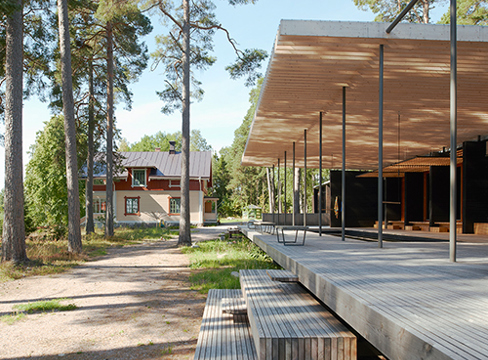Wood construction cuts climate footprint
The path to a climate-neutral society involves lower emissions, improved energy efficiency and greater carbon storage.
For the construction and real estate sector, this will have an impact on both the production and use phases. For newbuilds, this is about the choice of building materials and having a construction process with a low environmental impact and an energy-efficient building at the end of it. For existing buildings, the focus will largely be on energy efficiencies, since much of the environmental impact in the construction phase has already happened. Even here though, there are opportunities to reduce the climate impact via material choices during refurbishments and maintenance.
During the latter part of the 20th century, the focus was placed on limiting the climate impact during a building’s operational phase through reduced energy use. In more recent years, studies have shown that the construction process accounts for over 50 percent of a new building’s climate impact over its entire life cycle. This is largely because new buildings are becoming increasingly energy-efficient and renewable energy is being used for heating. Since the extraction and production of construction materials accounts for a substantial portion of the emissions during a building’s life cycle, impact on the climate must also be considered when choosing the materials and building system. For an accurate assessment to be achieved, wood’s carbon storage effect needs to be included in the calculations, since it is the only fully renewable construction material that stores carbon. Requiring a climate declaration during the construction phase is one element of the drive to reduce the impact that buildings have on the climate.
Modern wood construction is on the rise
Wood has long been the dominant construction material for smaller buildings, with a market share of over 90 percent. Although industrial construction of larger residential buildings is a relatively young sector in Sweden, it has grown rapidly since the ban on building higher than two storeys in wood was lifted in the mid-1990s. Now modern wood construction of apartment blocks has a market share of around 15 percent, and interest continues to grow.
In recent years there has been a crucial breakthrough in industrial wood construction, with increased investment in industrial buildings and the development of processes and technology driving up the capacity for building apartment blocks in wood. A great deal of investment has been ploughed into new production units for prefabricated modules and various construction systems based on wood, such as glulam, laminated veneer lumber (LVL), lightweight joists and beams and mass timber construction using cross laminated timber (CLT), all of which make it possible to increase production capacity while at the same time reducing climate impact. Several local authorities have been instrumental in increasing demand by developing municipal wood construction strategies.
The low weight of the wood raw material opens up opportunities for greater prefabrication and industrial production of components, which are then assembled on the construction site. Greater load-bearing capacity and longer spans can be achieved using glulam and CLT elements. This makes it possible to build taller wooden buildings with prefabricated walls and floor systems and on-site assembly. Apartment blocks with over eight storeys are already being built this way in Sweden.
A high degree of prefabrication in the industry also drastically reduces the number of deliveries to the construction site, which is a major benefit not only for the environment, but also for the traffic situation and the local residents.
In 2019, the wood construction sector submitted its roadmap for 2025 to the Swedish government. The roadmap was drawn up by the whole wood construction sector and should be seen as an offer to a government that, in two policy statements, has emphasised the importance of expanding industrial construction in wood. It paints a picture of a growing industry that is redefining the building process and radically reducing the climate footprint of the construction sector.
Greater wood construction is part of the solution to demand for more housing and a key factor in achieving our goals concerning climate neutrality. If, by 2025, half of Sweden’s apartment blocks were built in wood instead of other materials, the climate impact in the construction phase could be cut by around 40 percent annually. Coupled with greater wood construction in public and private property developments, this would amount to around 1 million tonnes of carbon dioxide per year. If wood’s carbon storage is added to the substitution effect, the calculated saving comes in at 2–4 million tonnes of carbon dioxide per year.
Standards and Environmental Product Declarations
There are a number of standards that can be used to assess a building’s environmental impact. This work is being conducted internationally, within the EU and in each separate country. In Sweden, the Swedish Standards Institute (SIS) is responsible for the standardisation work. The work is being carried out in consultation with businesses and organisations.
In the drive towards the objective that all buildings are developed with minimal climate impact during the production of the construction materials, the construction itself, operation of the building and its demolition and final processing, everyone in the construction process will be affected. For newbuilds, data on a building’s environmental impact must be produced, so that the developer can compare different proposals against each other.
There are environment-related steering standards and documents that are hierarchically coordinated, as set out below.
The basis for all standards on the environment is ISO 9001 and ISO 14001. Then come the standards for life cycle assessments. ISO 14040, ISO 14044 and ISO 14025 describe how to transfer the results from the life cycle assessment to an Environmental Product Declaration.
Product Category Rules (PCR) set out how to draw up an Environmental Product Declaration for a particular product group. PCR SS-EN 15804 is used for construction products and PCR SS-EN 15978 for buildings. In simplified terms, the differences between the two methodology standards are that SS-EN 15978 generates data to be able to compare the environmental impact of different buildings, while SS-EN 15804 helps with the declaration of a specific material’s environmental impact. You can never compare wood with concrete or steel. However, you can compare different buildings and see their overall environmental impact. The standards should be used to study how different materials work in different contexts.
These standards make it possible to calculate and present comparative data on the sustainability of a built structure – throughout its entire life. In SS-EN 15804 and SS-EN 15978, the life cycle has been split into different phases, which in turn are divided into a number of modules.
- A 1-5: Production of the construction materials and the building
- B 1-7: The building’s use phase
- C 1-4: Demolition of the structure and waste management
- D: Recycling of the construction materials
Table 5 Environmental assessment of a building
| Life cycle information about the building | Other information | |||
| A 1-3 Production |
A 4-5 Construction |
B 1-7 Operation |
C 1-4 End of life |
D Other information |
| A1 Raw materials A2 Transport A3 Manufacture |
A4 Transport A5 Groundwork and erection plus installations on site |
B1 Use B2 Care and maintenance B3 Repairs B4 Replacement B5 Renovation and retrofitting B6 Energy B7 Water |
C1 Demolition |
Pros and cons outside the system parameters, e.g. environmental certification, energy recovery from wood. |
| Upstream | Central | Downstream | ||
| Detailed information if possible, otherwise from construction database. | Detailed information about manufacture of carcass, transport to and on construction site, energy use and waste when constructing the building. | B1–B5 as per appendix with standard times for maintenance and repairs. Energy use from energy calculation C1–C4, scenario for waste management using current methods. | Report any environmental information or other relevant information about the project.. | |
Källa: Tyréns
The positive properties of wood
Wood is a natural and renewable material that is produced locally for minimum transport needs. The by-products from production are used to generate energy, and the production process creates minimal waste. The material stores carbon dioxide throughout its lifetime, and at the end of its life it can be used as biofuel to replace fossil fuels.
The aim of the modules is to enable all the life cycle assessment (LCA) data to be separated out so that it is clear where the environmental impact arises and where environmental gains are generated. The standards are to be used for a declaration of environmental performance, i.e. without levels and classes. However, these environmental declarations can be used as a basis for environmental certification schemes in which products or buildings are classified.
Environmental certification of buildings
There are currently generally adopted ways of calculating a building’s climate impact over its whole life cycle. There are also a number of environmental certification systems, such as Miljöbyggnad, LEED and BREEAM, which use LCAs to classify the environmental performance of buildings. Some of these systems can be used for newbuilds and existing buildings. The only ecolabelling system for buildings that does not use an LCA or Environmental Product Declaration as part of its classification system is the Nordic Swan Ecolabel.
Green Building is a European system aimed at property owners and managers who want to make energy use in their premises and homes more efficient. The requirement is that the building uses 25 percent less energy than previously, or compared with Sweden’s newbuild requirements in Boverket’s Building Regulations (BBR).
Leadership in Energy and Environmental Design (LEED) is an environmental certification system from the USA that is more comprehensive than the systems mentioned above. For example, LEED takes greater account of the production phase for the materials used in a building.
The BRE Environmental Assessment Method (BREEAM) comes from the UK and has more or less the same scope as LEED. BREEAM takes account of the production phase to some extent and also considers the environmental impact of the construction materials’ production from a life-cycle perspective.
The Nordic Swan Ecolabel sets requirements concerning energy use, chemical products, construction products and a number of indoor environment factors that are relevant for human health and the environment. In addition, the Nordic Swan Ecolabel requires quality assurance of the construction process and regarding the handover of the building to the residents, plus its management/operation.
 Geschwornergården, Falun.
Geschwornergården, Falun.


